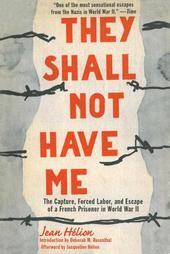
|
They Shall Not Have Me: The Capture, Forced Labor, and Escape of a French Prisoner in World War II
Hardback
Main Details
| Title |
They Shall Not Have Me: The Capture, Forced Labor, and Escape of a French Prisoner in World War II
|
| Authors and Contributors |
By (author) Jean Helion
|
|
Introduction by Deborah Rosenthal
|
|
Afterword by Jacqueline Helion
|
| Physical Properties |
| Format:Hardback | | Pages:448 | | Dimensions(mm): Height ,Width 140 |
|
| Category/Genre | Memoirs
Second world war |
|---|
| ISBN/Barcode |
9781611455014
|
| Classifications | Dewey:940.547243092 |
|---|
| Audience | |
|---|
|
Publishing Details |
| Publisher |
Skyhorse Publishing
|
| Imprint |
Arcade Publishing
|
| Publication Date |
31 May 2012 |
| Publication Country |
United States
|
Description
The French painter Jean Helion's unique and deeply moving account of his experiences in Nazi prisoner-of-war camps prefigures the even darker stories that would emerge from the concentration camps. This serious adventure tale begins with Helion's infantry platoon fleeing from the German army and warplanes as they advanced through France in the early days of the war. The soldiers chant as they march and run, "They shall not have me!" but are quickly captured and sent to hard labor. Writing in English in 1943, after his risky escape to freedom in the United States, Helion vividly depicts the sights, sounds, and smells of the camps, and shrewdly sizes up both captors and captured. In the deep humanity, humor, and unsentimental intelligence of his observations, we can recognize the artist whose long career included friendships with the likes of Mondrian, Giacometti, and Balthus, and an important role in shaping modern art movements. Helion's picture of almost two years without his art is a self-portrait of the artist as a man.
Author Biography
Jean Helion was a noted French modernist painter and author. He was a member of the Free French Forces during World War II. sHis work later influenced Roy Lichtenstein, Nell Blaine, and Leland Bell-it can be seen at the Museum of Modern Art, the Art Institute of Chicago, and the Tate Gallery in London. He died in 1987. Deborah M. Rosenthal is Consulting Editor for the series. She is a painter who has shown in New York and nationally during the past twenty-five years. For her writing on art in many journals, including Art in America and Modern Painters, she won an NEA Critic's Grant. She is Professor of Fine Arts in the School of Fine and Performing Arts of Rider University. Jacqueline Helion was married to the renowned modernist painter Jean Helion from 1963 until his death in 1987. She lives in France.
ReviewsJean Helion was one of France's leading modernist painters, even before his capture by the Germans in 1940 when he was 33. His account of his adventures in captivity is both terrifying and funny (one of his tormentors was the appropriately-names Kommandofuhrer Jurk), somewhat in the Vein of Tarantino's film Inglorious Basterds. A best-seller after it was published in America while the war was still raging, it has remained for many, including Helion's legions of admirers in both France and the United States, a one-of-a-kind classic. It's wonderful to have it back in print again. --John Ashbery The French armistice with the Third Reich, signed by Vichy's aging Marshal Petain on June 22, 1940, stipulated the following: "The French armed forces in the territory to be occupied by Germany are to be hastily withdrawn into the territory not to be occupied, and be discharged." No wonder, then, that hundreds of thousands of exhausted French soldiers allowed themselves to be encircled by German troops and held in barbed-wire enclosures pending their expected demobilization. Most believed they would be going home.The German high command had a different agenda. Hitler, who would break his pact with Stalin and invade the Soviet Union within a year of signing the Vichy agreement, planned to replace the German manpower needed for the Russian front with the labor of the surrendered French army. Trains crammed with prisoners would soon make the four-day journey to hastily constructed barracks at dozens of sites near the former Polish border. Such was the fate of close to a million and a half French prisoners of war, most of whom would not see their home again for five years; 25,000 would never return.In New York, in 1943, a detailed eyewitness account of the conditions in German POW camps was published by a French escapee, Jean Helion (1904-87). Helion was by then an internationally known painter who had been living in New York at the outbreak of World War II. He returned to France for military service, only to be part of the debacle that followed the German invasion. At the request of E.P. Dutton publishers, he set down his experience in "They Shall Not Have Me," a meticulously observed description of the lives of French POWs as virtual slaves of the Third Reich, with vivid delineations of both captors and captives.Written in English and never published in France, the book became a best seller, and its author found himself in demand for lectures and interviews, trying, as he said, to tell Americans what it was like to be hungry, devoured by lice, worked to the bone, and Jean H lion was one of France's leading modernist painters, even before his capture by the Germans in 1940 when he was 33. His account of his adventures in captivity is both terrifying and funny (one of his tormentors was the appropriately-names Kommandofuhrer Jurk), somewhat in the Vein of Tarantino's film Inglorious Basterds. A best-seller after it was published in America while the war was still raging, it has remained for many, including Helion's legions of admirers in both France and the United States, a one-of-a-kind classic. It's wonderful to have it back in print again. --John Ashbery
|